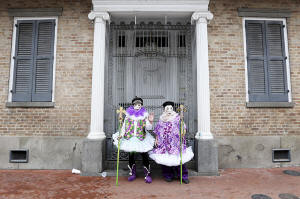As Mardi Gras approaches in New Orleans, maskers and parades take center
stage
 [February 27, 2025]
By JEFF AMY, JACK BROOK and STEPHEN SMITH [February 27, 2025]
By JEFF AMY, JACK BROOK and STEPHEN SMITH
NEW ORLEANS (AP) — Carnival season 2025 is approaching its climax in New
Orleans and across the Gulf Coast, with big parades rolling down the
main routes as some revelers get fancied up for formal balls while
others dress in costume to poke fun and make merry.
Three parades will roll Thursday night in New Orleans with scores of
masked riders on colorful floats. More processions will continue every
day through Mardi Gras, or Fat Tuesday. Costumed revelers will jam the
French Quarter as more parades roll in New Orleans' suburbs, other
Louisiana cities, and all along the Mississippi and Alabama coasts.
What is Mardi Gras?
Carnival in New Orleans and around the world is rooted in Christian and
Roman Catholic traditions. The season begins on Jan. 6, the 12th day
after Christmas, and continues until Mardi Gras, which is the final day
of feasting, drinking and revelry before Ash Wednesday and the fasting
associated with Lent, the Christian season of preparation for Easter.
Carnival celebrations have become thoroughly secularized in New Orleans,
where the largest and best-known celebrations in the U.S. include street
parties, fancy balls and boisterous parades. Some of the parades are
high-tech extravaganzas that feature massive floats laden with flashing
lights and giant moving figures.
“It’s all about family. It’s like a six-mile-long block party and
nothing could be more fun. It’s for everyone,” said Virginia Saussy of
the Krewe of Muses, which is set to parade Thursday night. "You got to
come experience it to understand.”

How else do people celebrate Mardi Gras?
On Mardi Gras in southwest Louisiana, some people will take part in the
Cajun French tradition of the Courir de Mardi Gras, or Fat Tuesday Run.
These rural processions, with links to rituals from medieval France,
feature masked and costumed riders, with stops where participants
perform and beg for goods. Inebriated maskers often chase live chickens
to include in a communal gumbo at the end of the day.
In New Orleans, some African Americans mask in elaborate beaded and
feathered Mardi Gras Indian suits, roving the city to sing, dance, drum
and perform. The tradition, a central part of the Black Carnival
experience in New Orleans since at least the late 1800s, is believed to
have started in part as a way to pay homage to area Native Americans for
their assistance to Black people and runaway slaves. It also developed
at a time when segregation barred Black residents from taking part in
whites-only parades.
How is New Orleans reacting to the New Year's Day attack?
Following the Jan. 1 truck attack that killed 14 people in the heart of
New Orleans, the Department of Homeland Security upgraded Mardi Gras to
its highest risk rating. This means there will be significantly more law
enforcement officers present than in prior years, said Eric DeLaune, who
is leading Mardi Gras security as special agent in charge of Homeland
Security Investigations in New Orleans.
The city hosted the Super Bowl in early February and will employ many of
the same security measures: SWAT teams on standby, armored vehicles
along street corners, helicopters circling overhead and plainclothes
agents mingling in crowds. The city will deploy 600 police officers,
along with hundreds more from state and local agencies.
[to top of second column]
|

Jeff Thomas and Shelton Pollet find a rare peaceful spot on Bourbon
Street during Mardi Gras festivities in New Orleans, Feb. 25, 2020.
(AP Photo/Rusty Costanza, File)
 “We’ve made an effort to make
carnival season as safe as we possibly can without intruding on the
historical and cultural context of Mardi Gras,” said DeLaune, a
Louisiana native who grew up attending the parades. “We didn’t want
to change the feel of Mardi Gras.”
What are other security precautions?
Thousands of revelers will gather along the city’s oak and
mansion-lined St. Charles Avenue to watch towering floats, marching
bands and celebrities parade. To protect them, a “serpentine” layout
of heavy barricades has been arranged on the road's opposite side to
bar fast-moving vehicles while still allowing traffic.
“You’re going to weave it like a snake,” New Orleans Police
Department Superintendent Anne Kirkpatrick told reporters at a
February press conference. “That will slow anybody down who thinks
they are going to use a vehicle as a weapon.”
Drones are banned, she added. Ice chests and coolers — which had
been used to plant explosives during the Jan. 1 attack -- will
remain barred from the busiest section of the city’s historic French
Quarter, said Louisiana State Police Superintendent Robert Hodges.
Why is Mardi Gras so late this year?
Because it’s linked to Easter, the date of Mardi Gras can fall
anywhere between Feb. 3 and March 9. That’s because Easter falls on
the first Sunday after the first full moon after the beginning of
spring in the Northern Hemisphere.
This year’s date of March 4 is one of the latest possible. That
means warmer temperatures are likely along the Gulf Coast rather
than the often cool and clammy weather of February. However, there’s
a chance of rain on Tuesday in the region.
What are ‘throws?’
“Throw” is a noun used to describe the trinkets that float riders in
parades and walking members of carnival clubs — known as krewes —
give to spectators. Shimmery strings of plastic beads are
ubiquitous, although some krewes are exploring alternatives out of
environmental concerns. Participants in the parade of New Orleans'
Zulu Social Aid and Pleasure Club hand out highly sought-after
painted coconuts.
At Thursday's Muses parade, glittery hand-decorated shoes are the
prize souvenir.
“The first year we created a bead that was a stiletto shoe and it
was just to be a commemorative bead — but it took off,” said Saussy,
who is the chairwoman of Muses' theme and floats. "People love
shoes, who knew?”
——
Amy reported from Atlanta.
All contents © copyright 2025 Associated Press. All rights reserved
 |